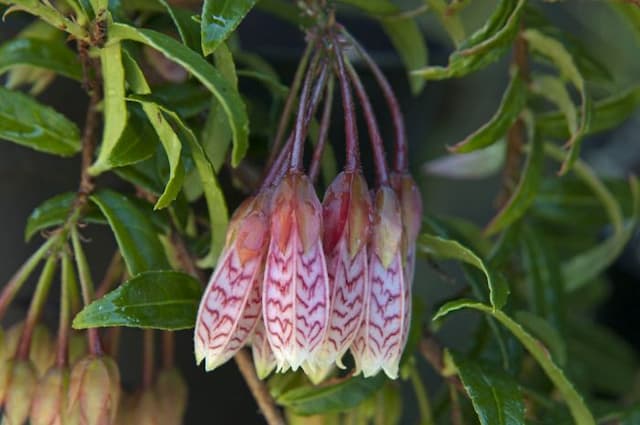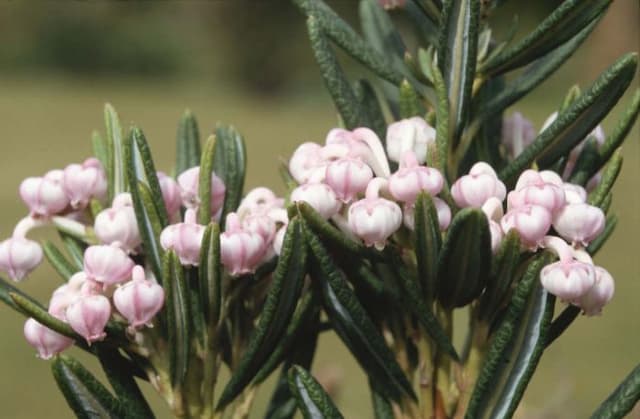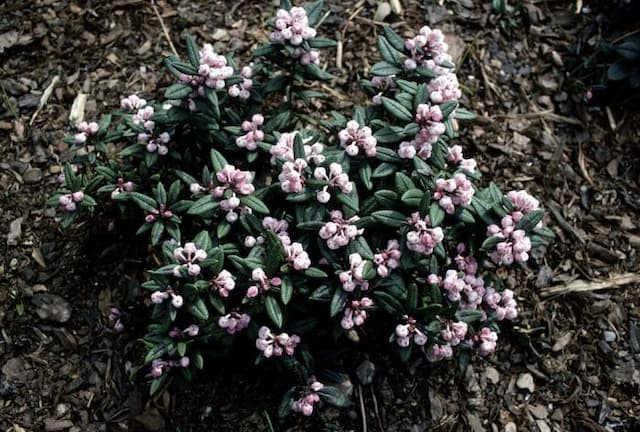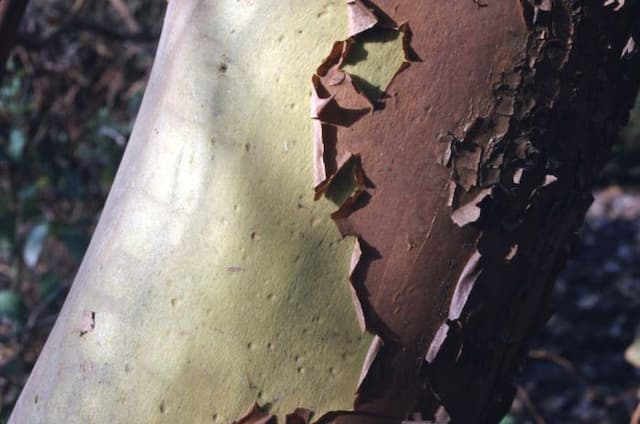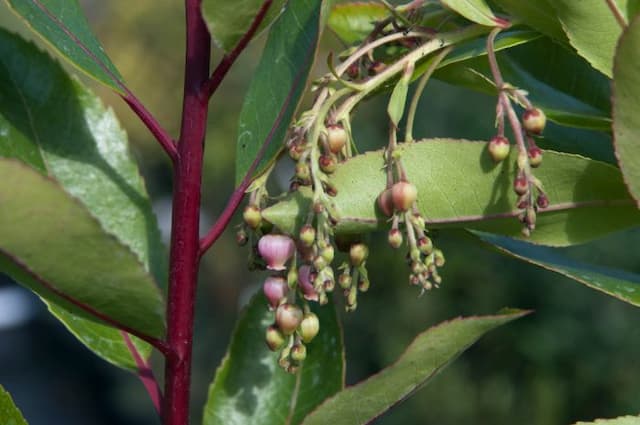Mackay's Heath Erica mackayana f. eburnea 'Shining Light'

ABOUT
'Shining Light' is a visually striking variety that features an abundance of small, bell-shaped flowers that are pure white in color, providing a brilliant contrast against the dark green foliage. The plant's leaves are fine and needle-like, with a dense and bushy habit that gives it a lush, textured appearance. The flowers bloom in clusters, creating a frothy, snow-like effect that is eye-catching in a garden setting. Despite its delicate appearance, 'Shining Light' has a robust nature, capable of providing vibrant color and visual interest in the landscape where it is planted.
About this plant
 Names
NamesFamily
Ericaceae
Synonyms
Shining Light Heath, White Heath
Common names
Erica mackayana f. eburnea 'Shining Light'.
 Toxicity
ToxicityTo humans
The plant commonly known as Heath is generally not considered highly toxic to humans. However, as with many plants, sensitivity can vary between individuals and it is still advisable to avoid ingesting any part of a Heath plant. If ingested, it might cause mild stomach upset or an allergic reaction in some people, though severe toxicity is unlikely.
To pets
Heath is not typically listed as highly toxic to pets, such as dogs and cats. While it's unlikely to cause serious harm if ingested in small amounts, it may still cause mild gastrointestinal upset in some animals. As pets can have individual sensitivities, it is best to prevent them from eating any part of a Heath plant to avoid potential digestive issues.
 Characteristics
CharacteristicsLife cycle
Perennials
Foliage type
Evergreen
Color of leaves
Green
Flower color
White
Height
1-2 feet (30-60 cm)
Spread
1-2 feet (30-60 cm)
Plant type
Shrub
Hardiness zones
7
Native area
Europe
Benefits
 General Benefits
General Benefits- Ornamental Value: Erica mackayana f. eburnea 'Shining Light', commonly known as Heather, has aesthetic appeal with its vibrant white flowers and evergreen foliage that can enhance garden appearance.
- Low Maintenance: Heather is known for being easy to care for, requiring minimal upkeep once established, making it a good choice for gardeners of all skill levels.
- Drought Resistance: Once established, Heather plants are relatively drought-resistant, making them suitable for gardens in regions with less frequent rainfall.
- Wildlife Attraction: The flowers of Heather attract pollinators such as bees, butterflies, and other beneficial insects, supporting local ecosystems.
- Soil Erosion Control: Heather's root system helps to stabilize the soil, preventing erosion especially in sloped areas or rocky landscapes.
- Year-Round Interest: With evergreen foliage and seasonal flowering, Heather provides visual interest throughout the year, unlike some plants that may go dormant.
- Cold Hardy: Heather is capable of withstanding cold temperatures, making it a suitable plant for cooler climates or higher altitudes where other plants may not thrive.
- Versatility in Landscaping: Heather can be used in various landscaping designs, including rock gardens, borders, ground covers, and as part of mixed shrubbery beds.
 Medical Properties
Medical PropertiesThis plant is not used for medical purposes.
 Air-purifying Qualities
Air-purifying QualitiesThis plant is not specifically known for air purifying qualities.
 Other Uses
Other Uses- Ornamental Topiaries: Heathers, including 'Shining Light', can be pruned into intricate topiaries for decorative garden art.
- Educational Tool: 'Shining Light' can serve as an educational tool in botany and horticulture classes for training on plant propagation and hybrid variations.
- Erosion Control: Its dense growing habit makes it useful for stabilizing loose soil on slopes and banks.
- Garden Design: With its bright foliage, 'Shining Light' heather can be used as a natural marker or border in garden design plans.
- Habitat Support: This plant provides shelter and habitat for various small insects and wildlife within a garden ecosystem.
- Photography: Its vibrant foliage and flowers make 'Shining Light' a desirable subject for botanical photography and plant portraiture.
- Aromatherapy Gardens: The subtle scent of 'Shining Light' when planted in large quantities contributes to aromatherapy gardens designed for relaxation.
- Frost Indicator: The early flowering nature of 'Shining Light' can serve as a phenological indicator of late winter or early spring frosts in gardens.
- Landscape Contrast: 'Shining Light' can be utilized for creating contrast with darker foliage plants or as a complement to other bright garden colors.
- Winter Gardens: The evergreen nature and winter-blooming flowers offer interest in winter gardens, a time when most other plants are dormant.
Interesting Facts
 Feng Shui
Feng ShuiThe heather is not used in Feng Shui practice.
 Zodiac Sign Compitability
Zodiac Sign CompitabilityThe heather is not used in astrology practice.
 Plant Symbolism
Plant Symbolism- Endurance: The hardy nature of this plant is often associated with the ability to endure challenging conditions, representing resilience and perseverance.
- Isolation: As the plant is known to thrive in harsh, isolated environments, it can symbolize solitude and the strength found within it.
- Protection: The dense foliage of heather is thought to provide shelter and protection, translating into a symbolic meaning of safety and care.
- Good fortune: In some cultures, heather is considered a lucky charm, believed to bring good fortune and positivity to those who keep it clos
- Admiration: The delicate appearance of the flowers is sometimes linked with admiration and the acknowledgment of someone's beauty and grace.
- Healing: Traditionally, heather has been used in medicinal remedies, symbolizing healing and the restoration of balance and well-being.
 Water
WaterThe Heather 'Shining Light' requires consistent moisture and should be watered deeply when the top inch of the soil feels dry, which is typically once a week. However, the frequency may need to be adjusted depending on climate conditions, such as increased frequency during hot, dry spells. Provide about 1 gallon of water at each watering to ensure the root zone is sufficiently moistened. It's important to avoid overhead watering to prevent fungal diseases, and instead, water directly at the base of the plant.
 Light
LightThe Heather 'Shining Light' thrives best in full sun to partial shade. Ideally, it should be placed in a location where it receives at least four to six hours of direct sunlight daily, but it can also tolerate some light dappled shade, especially in hotter climates.
 Temperature
TemperatureThe ideal temperature range for Heather 'Shining Light' is between 60 and 70 degrees Fahrenheit during the day, with cooler nighttime temperatures of around 40 to 50 degrees Fahrenheit. While it can survive winter cold down to around 10 degrees Fahrenheit, it is not tolerant of extreme heat, especially above 80 degrees Fahrenheit.
 Pruning
PruningPrune Heather 'Shining Light' to maintain shape and encourage bushy growth, typically after it has finished flowering in late spring. Pruning can be done once a year by trimming back the flowered stems to just below the spent blooms, also removing any dead or damaged branches. The best time for pruning is immediately after blooming to ensure the plant has time to set buds for the next season.
 Cleaning
CleaningAs needed
 Soil
SoilThe Heather 'Shining Light' prefers acidic soil with a pH between 4.5 and 5.5. A mix of peat moss, sand, and loamy soil is ideal. Ensure good drainage and avoid heavy, water-logged conditions to promote the plant's health.
 Repotting
RepottingHeather 'Shining Light' should be repotted every 2 to 3 years to refresh the soil and accommodate the growth of the plant. Repot in spring just before new growth begins.
 Humidity & Misting
Humidity & MistingHeather 'Shining Light' prefers moderate humidity levels. It tolerates some dry air but thrives best in an environment where the humidity is not too low, generally between 40-60%.
 Suitable locations
Suitable locationsIndoor
Place in bright, indirect light with acidic soil.
Outdoor
Plant in sun/partial shade, acidic, well-draining soil.
Hardiness zone
5-7 USDA
 Life cycle
Life cycleErica mackayana f. eburnea 'Shining Light', also commonly referred to as Heath, begins its life cycle with seed germination, which is facilitated by a combination of warm temperatures, adequate moisture, and sometimes fire or smoke, which mimics its natural habitat triggers. The seedlings emerge and grow, developing into young plants with needle-like foliage. As the plant matures, it enters a vegetative state where it expands in size and produces more stems and leaves. Eventually, it reaches the flowering stage, typically producing small, urn-shaped flowers that can attract pollinators such as bees. After pollination, the flowers develop into small capsules containing numerous seeds. When the seeds are mature, they are released into the environment to start the cycle anew, while the parent plant may continue to grow and flower for several years, given the appropriate conditions.
 Propogation
PropogationPropogation time
Spring-Early Summer
Propogation: Erica mackayana f. eburnea 'Shining Light', commonly known as Heather, is typically propagated through semi-hardwood cuttings. The ideal time for taking cuttings is in late summer after the plant has flowered and new growth has begun to mature. To propagate Heather, a gardener would snip a 4 to 6-inch (10 to 15 cm) length of stem that has several sets of leaves. This cutting should be taken from a healthy part of the plant, avoiding any woody or overly soft sections. It's important to use a sharp, sterile cutting tool to prevent infection and ensure a clean cut. The bottom leaves are then stripped off, and the cut end dipped in rooting hormone to encourage root development. The prepared cutting is placed into a well-draining potting mix and kept moist until roots form, which typically takes several weeks. During this time, the cutting should be kept in a warm area with indirect sunlight to foster the best growing conditions.
